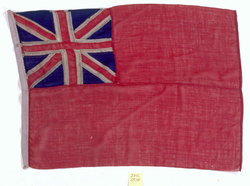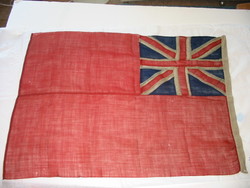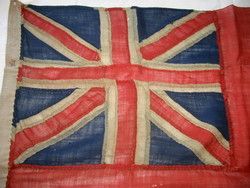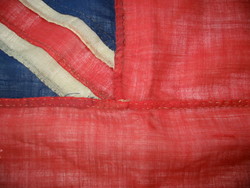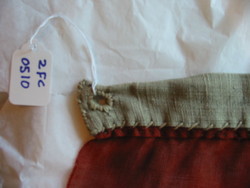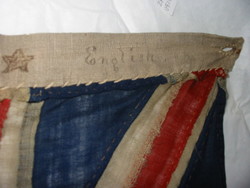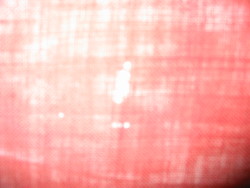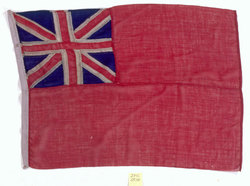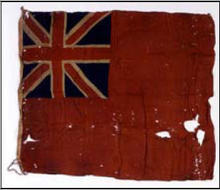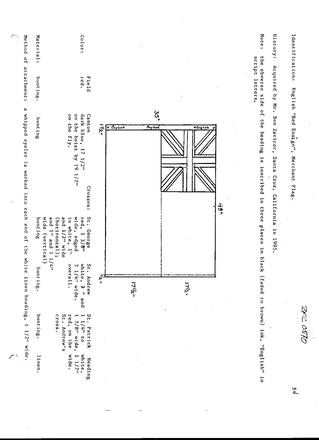U.K. Confederate Blockade Runner, "ruse de guerre" ensign, 1861 - 1865.
While the early history of this flag is unknown, it was acquired from the personal collection of noted collector William H. Guthman, who founded Guthman Americana in Westport, Connecticut where he was a prominent antique dealer and a respected scholar and author. Guthman was considered a preeminent authority on Colonial and Federal period militaria.
Bill Guthman, an American-history buff since childhood, came to military antiques in 1966 after his profession as an executive at a textile manufacturing company. As a prominent antiques dealer he came to specialize in historical American military paraphernalia, bringing them to a position of significance in the collecting world. Guthman collected many artifacts from the French and Indian and Revolutionary Wars, and was one of the very first people to posit that militaria could also be considered folk art.
The Red Ensign or "Red Duster" has its origins in the 17th century as an ensign flown by the Royal Navy. The precise date of its first appearance is not known, but surviving documents indicate that the Royal Navy was fabricating such flags during the 1620s.
In 1707, an Act of Union united the Kingdom of Scotland with the Kingdom of England to create the Kingdom of Great Britain, resulting in a new red ensign. This flag placed the first Union Flag in the first quarter. The new design of the Red Ensign was proclaimed by Queen Anne, who indicated that it was to be used by both the unified navy and ships owned by "our loving subjects; and thus the civilian use of the red ensign commenced." In its present form, the Red Ensign dates from the change to the Union Flag beginning on January 1st, 1801. Since 1824 the red ensign has been the legal national colors of a British merchant vessel and in 1854, the Merchant Shipping Act included a specific provision that the Red Ensign was the appropriate flag for a merchantman from the United Kingdom. As such, red ensigns would have been commonly seen in the major ports and harbors of the world, and thus a familiar sight to all ships masters.
By the 1840s the proper ratio of height to width for all British national flags was 1:2. However, this ratio which seems so obviously correct now occurred largely by accident. Flags attained this elongated proportion because the table of sizes, issued by Samuel Pepys, Secretary of the Admiralty in 1687, laid down that flags should be made a yard long for every breadth of bewper (bunting) used in their construction. Later, bewper was woven in successively smaller widths, as mush of the bunting was woven on smaller domestic looms but the flags were still made-up in yard lengths. Consequently the proportions devolved from 11:18 in 1687 to 1:2 in 1837.
This flag does not have a 1:2 ratio, but rather proportions closer to a 10:14 ratio and therefore it is not constructed from breadths of bunting. Additionally, it is finished with whip stitched eyelets and is marked English. Lastly, as the Union Flag in the canton has nearly symmetrical red arms for the red diagonal St. Patricks Cross instead of the asymmetric cross specified on 1801, it is definitely not a flag of British manufacture.
Additionally, the marking English was a common American conceit used when referring to either the United Kingdom or the British. No red ensign made in the British Empire would ever have born the marking English.
As a result of these observations, this Red Ensign is believed to have been made in the Confederate States of America for use by blockade runners between 1861 and 1865. An ensign such as this would be used as both a courtesy signal and as the ruse de guerre termed 'false colors'.
To elaborate on the two potential uses for the flag, a courtesy signal (courtesy flag or courtesy ensign) is flown by a ship in foreign waters as a token of respect. It is a normally a national maritime flag of the host country. The flag is customarily worn at the foremasthead or at the starboard yardarm or crosstree of the mainmast, depending on the vessel's rigging. Conversely, a ruse de guerre or ruse of war is a legal action taken by a belligerent in warfare to fool the enemy in order to gain intelligence or a military advantage against the enemy. Disguising a warship to appear to be a neutral merchant vessel, or a merchant vessel on your opponent's side, has traditionally been considered a legitimate ruse de guerre, provided the belligerent raises their own flag to break the deception prior to firing their guns. This act was called sailing under false colors.
One famous example of the use of false colors was on September 4th, 1862 when the CSS Florida ran the Union Navy's blockade of Mobile Bay in Alabama. The CSS Florida, captained by Lieutenant John Newland Maffitt, was out of Havana with many of the crew were suffering from yellow fever. Despite being undermanned, Maffitt determined to make the dash into Mobile.
Upon arriving at the bar he discovered that three Union warships, the USS Oneida, the USS Winona, and the USS Rachel Seaman blocked his passage. He ordered for a red ensign to be displayed and sailed boldly forward into Mobile Bay. Ignoring the shot across his bow and the signal asking him to heave to he ran past the broadsides of USS Oneida. At this point the Florida was struck several times and severely damaged by shots from both the Oneida and the Winona. Still, the Florida was able to use hew superior speed to press on and in Maffitts own words, "I endeavored to make sail. Several men were wounded in the rigging. At this moment I hauled down the English flag, under which I had been sailing as a ruse de guerre, and gave the order to one of the helmsmen to hoist the Confederate flag. The Florida came to anchor safely under the guns of Fort Morgan in a much damaged condition, but lived to fight for the Confederacy another day".
This red ensign may be the only American made, and possibly Confederate made, foreign flag in private hands. It is very similar to another in the Museum of the Confederacy, from Collection #1906.08. The other flag in question is a 56" x 84" flag identified as a "British Red (Merchant) Flag", Capture history unknown. Transferred by U.S. War Department in 1906." An image for comparison is located in More Photos.
ZFC Significant Flag
Provenance:
• William Guthman of Westport, CT, until 1995.
• Acquired by purchase by the Zaricor Flag Collection, 1995.
Sources:
Madaus, Howard Michael, Rebel Flags Afloat: A Survey of the Surviving Flags of the Confederate States Navy, Revenue Service and Merchant Marine; Flag Bulletin No. 115, January-April, 1986, Vol.XXV, Nos. 1-2)
Madaus, Howard Michael, Wayne J. Lovett, illustrator, Confederate Flags at Sea, Flags of the Confederacy,15 November 2011, from:
http://www.confederate-flags.org/Confederate%20Flags%20At%20Sea-5.html
British Red (Merchant Flag), 1906.08, Flag, Museum of the Confederacy, 15 November 2011, from: http://www.moc.org/site/DocServer/Flag_Table_for_Website.pdf?docID=5741
Image Credits:
Zaricor Flag Collection
RTZFC


